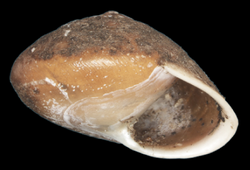Biology:Helicina guppyi
| Helicina guppyi | |
|---|---|

| |
| An apertural view of the shell of Helicina guppyi. Note the presence of the operculum. The height of the shell is 5.99 mm. | |
| Scientific classification | |
| Domain: | Eukaryota |
| Kingdom: | Animalia |
| Phylum: | Mollusca |
| Class: | Gastropoda |
| Subclass: | Neritimorpha |
| Order: | Cycloneritida |
| Family: | Helicinidae |
| Genus: | Helicina |
| Species: | H. guppyi
|
| Binomial name | |
| Helicina guppyi Pease, 1871[1]
| |
| Synonyms[2] | |
| |
Helicina guppyi is a species of tropical land snail with an operculum, a terrestrial gastropod mollusk in the family Helicinidae.
Shell description
The species is smaller and lower-spired than the other Dominican Helicina species, and always has a dull brown colour, a paler aperture and a hairy periostracum; ‘covered with a velvety epidermis’, weakly keeled, with a columellar denticle.[2] Its size is 5-8.5 mm.[2][clarification needed]
Distribution
This species lives in Guadeloupe, Dominica and in Martinique.[2]
This is the most common of the helicinids in Dominica, but generally restricted to the leeward side of the island.[2]
Taxonomy
Robert John Lechmere Guppy (1868)[3] described two taxa from Dominica based on shell variation within this species; both names were preoccupied.[2] William Harper Pease (1871)[1] provided a substitute name in his treatment of Indo-Pacific species.[2] This species was placed in the subgenus Striatemoda by Horace Burrington Baker (1940)[4] based on Guppy’s (1868) comparison with the Puerto Rican Alcadia subfusca (Menke, 1828), and also on Pilsbry’s (1892)[5] erroneous placement of this species with the Hispaniolan Alcadia rufa (L. Pfeiffer, 1857).[2] There is expected the forthcoming revision of the Lesser Antillean Helicinidae by Ira Richling (from Kiel, Germany).[2]
Ecology
This species is usually collected on the trunks of trees, where it is well camouflaged on tree bark, or among detritus and leaves on the ground.[2]
References
This article incorporates CC-BY-3.0 text from the reference.[2]
- ↑ 1.0 1.1 Pease W. H. (1871). "Catalogue of the land-shells inhabiting Polynesia, with remarks on their synonyms, distribution, and variation, and descriptions of new genera and species". Proceedings of the Zoological Society of London 1871: 449-477.
- ↑ 2.00 2.01 2.02 2.03 2.04 2.05 2.06 2.07 2.08 2.09 2.10 Robinson, D. G.; Hovestadt, A.; Fields, A.; Breure, Abraham (2009). "The land Mollusca of Dominica (Lesser Antilles), with notes on some enigmatic or rare species". Zoologische Mededelingen 83 (13): 615–650. https://repository.naturalis.nl/pub/311940.
- ↑ Guppy R. J. L. (1868). "On the terrestrial mollusks of Dominica and Grenada, with an account of some new species from Trinidad". Annals and Magazine of Natural History (4)1: 429-442.
- ↑ Baker H. B. (1940). "Striatemoda, new subgenus of Alcadia (?), type of A. (Emoda?) striata (Lamarck), from Puerto Rico". Nautilus 54: 71.
- ↑ Pilsbry H. A. (1892). "On a collection of land Mollusca from the Island of Dominica, West Indies". Transactions of the Connecticut Academy of Science 8: 356-358.
Wikidata ☰ Q5705005 entry
 |

